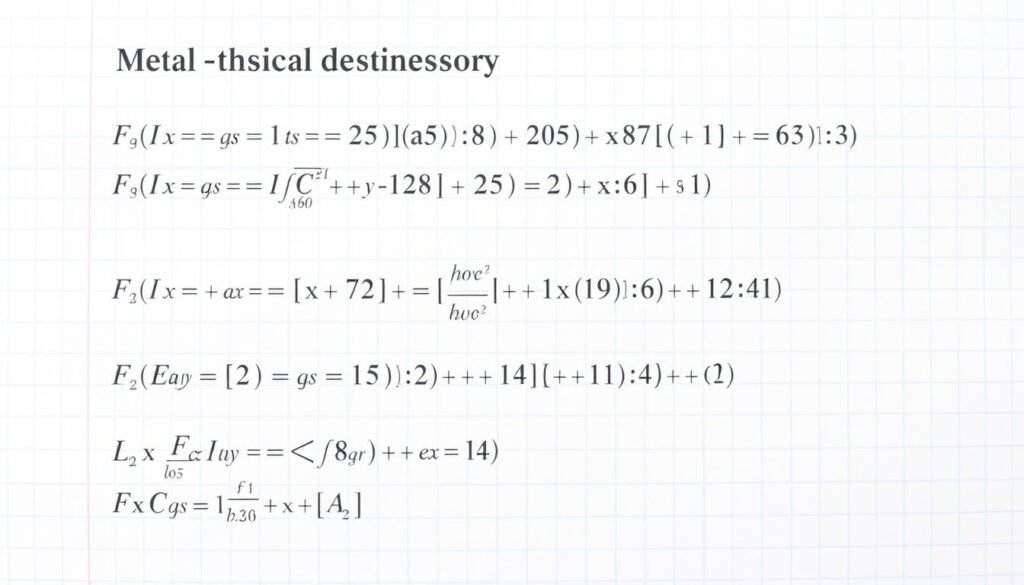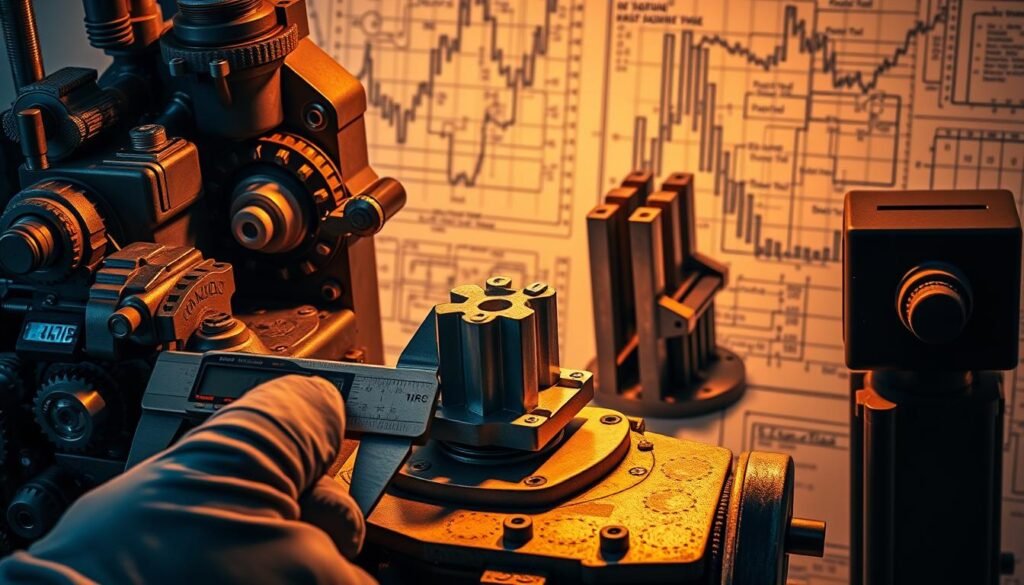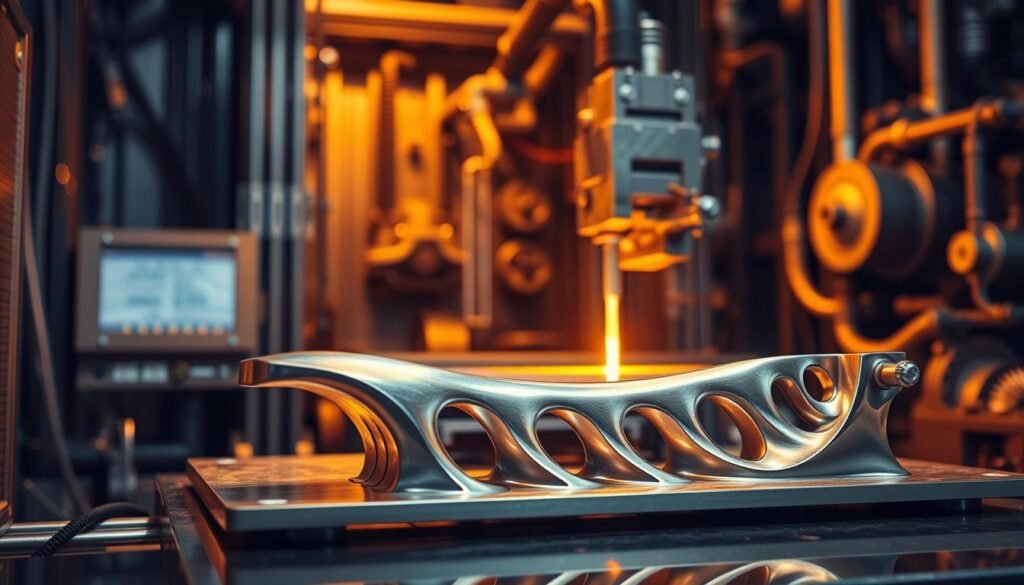Metal density is key in materials science. It shows how much mass is in a certain volume of metal. Knowing about metal density is vital in fields like aerospace, construction, and manufacturing.
Measuring density helps pick the right materials. It also impacts how well and safely metal parts work in different uses.
This guide explores metal density in detail. It shows why it matters so much. For more info, check out expert insights on metal density. They cover many important points about this topic.
Introduction to Density
Understanding the definition of density is key for both students and professionals. Density is the mass of an object divided by its volume. It’s shown in the formula: density = mass/volume. This basic property helps us know materials by how tightly their atoms or molecules are packed.
Different substances have unique densities. This leads to many uses in various fields.
Definition of Density
So, what is density? It shows how tightly packed a material is. Each substance, like metals, has a specific density. This comes from the size, mass, and arrangement of its atoms.
For example, aluminum has a density of 2.9 g/cm3. Copper can be up to 9.3 g/cm3. These differences are important in engineering and manufacturing.
Importance of Density in Materials Science
The importance of density in materials science is huge. It affects material choice and structural strength. For instance, knowing a material’s density helps engineers predict its behavior under stress and temperature changes.
Density is a key part of materials science. It ensures safety and effectiveness in construction, transportation, and more. For more info, check out this materials science resource.
What is Metal Density?
Metal density is key when we look at materials, mainly metals used in many ways. Knowing how to measure metal density is vital. It affects how well a material works and if it’s right for certain jobs. The main formula for density shows a simple link between mass and volume.
Understanding Density Formulas
The basic formula for density is ρ = m/V. Here, ρ is density, m is mass, and V is volume. This density calculation shows how these elements relate to each other. It helps us understand the properties of different materials.
Using metal density formulas tells us not just how dense a material is. It also shows its structure, purity, and what it can be used for.
Units of Measurement for Metal Density
When we talk about units of metal density, we mainly use grams per cubic centimeter (g/cm³) and kilograms per cubic meter (kg/m³). Usually, g/cm³ is used in materials science for solid metals. On the other hand, kg/m³ might be better in certain industrial settings.
Choosing the right density measurement units is critical for precise assessments in density equations. This leads to accurate interpretations of material properties.

Factors Influencing Metal Density
Understanding what affects metal density is key to knowing about materials. Important factors include atomic mass, how atoms pack, temperature, and pressure. Each one affects how dense a metal is.
Atomic Mass and Density
The link between atomic mass and density is basic in materials science. Heavier elements like gold are denser than lighter ones like aluminum. This helps us choose the right metal for a job.
Atomic Packing Structure
The way atoms pack affects a material’s density. In tight packs, like face-centered cubic (FCC), atoms take up less space. This makes the material denser and stronger, useful in many industries.
Temperature Influence on Density
Temperature changes how dense a metal is. When it gets hotter, metals expand and get less dense. This is why keeping temperature steady is important in metal work.
On the other hand, cooling metals makes them denser. This is useful for many uses.
Effect of Pressure on Density
High pressure makes metals denser. This is more noticeable in gases than solids and liquids. Knowing this helps in making materials with specific properties.
Typical Densities of Common Metals
Knowing the typical densities of common metals is key in many industries. It affects what materials are chosen for building, making things, and more. The metal density values show how different materials compare, giving insight into their unique traits. These figures are found in the density of metals table, a helpful tool for engineers and designers.
| Metal | Density (kg/m³) |
|---|---|
| Aluminum | 2,705 |
| Brass | 8,587 |
| Copper | 8,944 |
| Gold | 19,320 |
| Iron | 7,860 |
| Lead | 11,343 |
| Silver | 10,497 |
| Titanium | 4,520 |
Alloy density values can be quite different from pure metals. For example, brass, made of copper and zinc, has a density that changes with the mix of metals. This makes it interesting to compare pure metals and alloys. It shows how density changes can affect how materials perform.
Procedure to Determine Metal Density
To find the density of metal, you need to measure carefully and use the right density testing tools. A clear metal density determination procedure is key for precise results. This method is easy and needs only basic tools, making it useful for many situations.
Equipment Required
The main equipment for density determination includes:
- Balance for weighing the metal sample
- Beaker filled with water
- Nylon thread for suspending the metal object
Step-by-Step Methodology
Here are the steps to measure density for quick calculations:
- Weigh the metal specimen in air using the balance.
- Immerse the metal sample in the beaker of water.
- Record the apparent weight of the metal when submerged.
- Calculate the density using the formula involving the weights from the previous steps.
Calculating Metal Density
Knowing how to measure and calculate metal density is key in science and industry. The right formulas make it easy to find metal density. This is important for choosing the right materials for different uses. The basic formula is ρ = m/V, where ρ is density, m is mass in grams, and V is volume in cubic centimeters.
This simple equation is used a lot in real-world density calculations.
Formula for Density Calculation
The formula ρ = m/V is the foundation for many density calculations. To use it, you need to know the metal’s mass and volume. For example, if a metal weighs 200 grams and has a volume of 100 cubic centimeters, its density is:
ρ = 200 g / 100 cm³ = 2 g/cm³
This shows the metal’s density and helps compare it with other metals. It makes identifying materials easier.
Examples of Density Calculations
Let’s look at aluminum, used a lot in building and making things. A 150-gram aluminum sample with a volume of 55 cubic centimeters has a density of:
ρ = 150 g / 55 cm³ ≈ 2.73 g/cm³
These examples show how accurate measurements help us understand materials. By using density formulas, experts can trust the data they get from metal density tests.

Real-World Applications of Metal Density
Metal density is key in many industries. It affects how well materials work, stay safe, and are effective. This is true in aerospace, construction, and healthcare.
Use in the Aerospace Industry
In aerospace, density is very important. We need materials that are light but strong. This is why metals like aluminum or titanium are chosen.
These metals have the right mix of strength and lightness. This helps planes fly better without being too heavy.
Role in Construction and Manufacturing
In building things, density matters a lot. It helps make structures strong and safe. Engineers use density to design buildings and roads.
Choosing the right materials saves money and makes projects bigger. Using density well also makes making things more efficient.
Importance in Medical Devices
In healthcare, metal density is very important. The right metals are needed for medical tools and implants. Titanium is often used because it’s strong and safe for the body.
Designing with the right density makes sure these devices work well. It also keeps patients safe.
Metal Density and 3D Printing
In 3D printing, the materials used are key to an object’s success. Metals and alloys are at the heart of new designs and uses. They show how important density is in 3D printing.
Common Metals and Alloys Used in 3D Printing
Many metals are chosen for 3D printing because of their great qualities. Here are some:
- Titanium: It’s loved for being strong yet light.
- Stainless Steel: It’s tough and doesn’t rust easily.
- Aluminum Alloys: They’re light but strong, perfect for complex shapes.
These metals are popular in fields like aerospace and medical devices. They need to be strong and reliable.
Density Considerations for Additive Manufacturing
Knowing about density in 3D printing is vital. It affects how well parts work. Density impacts:
- Structural Integrity: It’s key for parts to handle stress well.
- Weight Specifications: It’s important for things where weight matters, like in space.
- Material Performance: It affects how parts handle heat and electricity, which is important for their use.
By focusing on density, designers can pick the best materials for their needs. This makes products work better and last longer.

Conclusion
Metal density is key in many fields. Knowing how factors like temperature and atomic structure affect it helps pick the right materials. This knowledge boosts performance in areas like aerospace and medicine.
Understanding metal density is vital. It helps choose materials for weight-sensitive tasks. This knowledge also moves materials science forward.
If you want to learn more, check out this guide on metal density. It offers a detailed look. Knowing about metal density is critical for today’s and tomorrow’s engineering and manufacturing.
